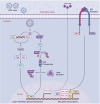Molecular epidemiology and immunopathogenesis of bovine viral diarrhea virus: a growing threat to regional cattle industry of Xinjiang, China
- PMID: 40727566
- PMCID: PMC12302146
- DOI: 10.3389/fmicb.2025.1617998
Molecular epidemiology and immunopathogenesis of bovine viral diarrhea virus: a growing threat to regional cattle industry of Xinjiang, China
Abstract
Bovine viral diarrheal virus (BVDV), identified as a serious global pathogen, presents a significant and formidable challenge for the global cattle sector. This presents not only serious economic consequences but also serious immunopathological consequences causing lasting impacts. In the Chinese province of Xinjiang, where the ruminants are high and the topographical features unique and contribute towards complex epidemiology, multiple genotypes of the BVDV are continuously interacting and adapting. This includes the persistent presence of the earlier predominant BVDV1, the rising trend towards the antigenically complex BVDV2, and the recent presence of the HoBi-like (BVDV3) strain, contributing toward complexity. The purpose of this review is to present a detailed analysis relative to the molecular epidemiology, genomic diversity levels, and complex pathology associated with the persistence and spreading of the infection by the BVDV. In light of the country's inability to execute the efficacious eradication of the infection, stringent biosafety measures need to be adopted, the genomic investigation has to be increased, and the establishment of the multi-valent vaccine for the induction of the local strain of the infection should be encouraged. These steps need to be taken towards the rising danger of the presence of the BVDV, not only towards the province but also towards the larger territories beyond.
Keywords: Xinjiang; bovine viral diarrhea; bovine viral diarrhea virus; epidemiology; pathogenesis; prevalence.
Copyright © 2025 Gao, Kuang, Yin, Zhang, Kulyar and Hu.
Conflict of interest statement
JG, JY, and MZ were employed by Xinjiang Production and Construction Corps. The remaining authors declare that the research was conducted in the absence of any commercial or financial relationships that could be construed as a potential conflict of interest.
Figures






Similar articles
-
Respiratory illness in young and adult cattle caused by bovine viral diarrhea virus subgenotype 2b in singular and mixed bacterial infection in a BVDV-vaccinated dairy herd.Braz J Microbiol. 2024 Dec;55(4):4139-4146. doi: 10.1007/s42770-024-01476-x. Epub 2024 Aug 15. Braz J Microbiol. 2024. PMID: 39143403
-
Deletion viral genome diversity among bovine viral diarrhea virus (BVDV) 1a and 1b strains.Virol J. 2025 Jul 14;22(1):237. doi: 10.1186/s12985-025-02773-z. Virol J. 2025. PMID: 40653488 Free PMC article.
-
A systematic review of financial and economic assessments of bovine viral diarrhea virus (BVDV) prevention and mitigation activities worldwide.Prev Vet Med. 2017 Feb 1;137(Pt A):77-92. doi: 10.1016/j.prevetmed.2016.12.014. Epub 2016 Dec 23. Prev Vet Med. 2017. PMID: 28040270
-
Serosurvey of Bovine Viral Diarrhea Virus in Cattle in Southern Japan and Estimation of Its Transmissibility by Transient Infection in Nonvaccinated Cattle.Viruses. 2025 Jan 2;17(1):61. doi: 10.3390/v17010061. Viruses. 2025. PMID: 39861850 Free PMC article.
-
Antidepressants for pain management in adults with chronic pain: a network meta-analysis.Health Technol Assess. 2024 Oct;28(62):1-155. doi: 10.3310/MKRT2948. Health Technol Assess. 2024. PMID: 39367772 Free PMC article.
References
-
- Ahn B. C., Walz P., Kennedy G. A., Kapil S. (2005). Biotype, genotype, and clinical presentation associated with bovine viral diarrhea virus (BVDV) isolates from cattle. J. Appl. Res. Vet. Med. 3:319–325.
-
- Benavides B., Casal J., Diéguez J., Yus E., Moya S. J., Allepuz A. (2021). Quantitative risk assessment of introduction of BVDV and BoHV-1 through indirect contacts based on implemented biosecurity measures in dairy farms of Spain. Prev. Vet. Med. 188:105263. doi: 10.1016/j.prevetmed.2021.105263, PMID: - DOI - PubMed
Publication types
LinkOut - more resources
Full Text Sources

